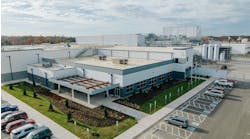The challenges of automation are arguably heightened in beverage plants. They often combine slow batch production with high-speed filling and other packaging operations, making coordination difficult.
Packaging equipment operating at these high speeds is often prone to interruptions, further complicating coordination with processing. Trade customers are asking for increasingly customized and elaborate variations in pack patterns that require high flexibility to fulfill.
Challenges in beverage automation range from mundane considerations, like keeping a system moving and not allowing interruptions to get out of hand, to more ambitious ones like contextualizing data for predictive maintenance and other purposes. Meeting them requires a mix of mechanical and digital strategies.
One of the most basic functions of automation in a beverage plant (as well as in many others) is prevention of fundamental mistakes, like mismatching product with packaging. These can happen surprisingly often, just because operators aren’t looking for them, says Raymund Alfaro, director of business development for Gray Solutions (www.gray.com).
“There’s been rare cases where they were running orange product being packaged in a grapefruit bottle,” Alfaro says. “Running a full shift, and somebody just happened to be going to third shift and they go, ‘Why do I see grapefruit? I know we’re running orange.’ It’s funny because that’s what the QA is supposed to do, but when you’re doing it all the time, you just assume, ‘Hey, it’s in the right package.’”
That customer invested in an improvement to their automation system that reads the labels on containers about to be filled and makes sure it matches what is supposed to be coming out of the fillers.
In many cases, keeping a system moving is simply a matter of building in enough absorption capacity, Alfaro says. This capacity should be upstream of the packaging equipment that is most prone to interruptions, like cartoners or case-packers. It usually takes the form of tables or stacked accumulators that allow cans or bottles to collect while a downstream problem is being resolved.
Sometimes extra-long conveyors can do the trick. Alfaro remembers a plant in Ohio that had conveyor lines literally a mile long (although it also used accumulation tables) to absorb backlogs.
Space is precious
But long conveyors increasingly are not an option as companies look to conserve space, says Brigadare Manradge, a packaging engineer with architectural and construction firm CRB Group (www.crbgroup.com).“The industry is not necessarily going to more conveyors, as that takes up more precious real-estate space,” Manradge says. “One main driver is, if it’s a greenfield project, trying to keep the initial capital costs down, or for a brownfield project, dedicating more square footage to actual production equipment.”
A common setup is to have individual conveyor lanes dedicated to specific SKUs, often fed by different fillers. Changes in the SKUs being case-packed or palletized are handled by gates or other diverters in those conveyors that reroute the SKUs to different end-of-line equipment.
However, that doesn’t work so well in situations where frequent SKU changeover is required. That’s been a factor for years, as large trade customers increasingly demand customized mixes for cases and even six- or 12-packs.
“I think where the challenges are coming in is in the variety packs, to where you’re having multiple flavors, multiple points of entry onto the machine itself,” says Aaron Metzler, director of sales and applications for Serpa Packaging (www.serpapackaging.com), a supplier of end-of-line packaging equipment. “And then marketing wants the cans in certain orders and certain fashions inside the carton.”
Automation has a role to play in such cases. For a variety pack at relatively high speeds, a robot can detrain a 24-pack of cans, put them into an accumulation area and then bring them back into the lanes as needed.
Getting digital
Of course, many of the challenges and opportunities relating to automation have to do with digital information – how it’s stored, transmitted, received and used.
Perhaps the most basic form of use is the human-machine interface (HMI) – the software that allows floor operators to control the equipment. Too often it’s too hard for floor personnel, especially younger ones, to decipher the HMI that comes with the equipment they’re running.
“Most clients are actually wanting the HMIs to be much more interactive to a younger workforce having less of a technical background, so that people can understand what’s wrong with the equipment and be able to repair the equipment quickly,” Manradge says.
Part of the problem, he adds, is that many HMIs were designed by engineers who “haven’t spent time with any operations personnel on the floor who may not have an engineering degree. So sometimes the description of a problem is very engineering-based” and harder for operators to understand.
The question of communication – between operators and machines and between machines and other devices on line – is central to automation considerations. As the capacity of equipment to self-diagnose improves, so must the ability to pass along and use the data they put out.
Equipment in general has a higher capability to indicate when something is going wrong. This is especially important with packaging equipment, which often uses many axes of motion that must be coordinated with each other; one of them going out of whack will bring the whole machine to a halt.
Sometimes packaging equipment can also keep track of outages elsewhere on the line, says Peter Fox, CEO of Somic (www.somic-packaging.com), a supplier of end-of-line packaging equipment. "Somic collects data regarding uptime, machine faults, the reasons for faults and overall run time efficiencies. This data is commonly used by our customers to determine the overall line efficiencies since we are typically the end-of-line.
“Therefore, we can collect data like ‘waiting for product’ as a result of upstream equipment downtime or failures,” Fox continues. “Our system provides pie charts and other graphical output to quickly evaluate a line's performance.”
According to Jon Gaiser, Serpa’s electrical engineering manager, the kinds of data that can be extracted from Serpa equipment include alarms, used to generate historical and predictive maintenance and identify source of production stoppages; statistical data, used to generate production reports for trend analysis; and equipment states, useful in seeing which assets on the production line are in which states of the production process.
Speaking the same language
For this data to be useful, it has to be readily available and uniform across the system. The same thing goes for automation in general; standardization in digital controls is key. Unfortunately, that’s not easy to come by, especially in brownfield projects where an existing facility is retrofitted, says Matthew Hansen, strategic business manager with Rockwell Automation (www.rockwellautomation.com).
“One of the major challenges when attempting to coordinate and integrate an entire plant (specifically a brownfield) is the wide variety of various control and automation equipment of different vintages and from different vendors,” Hansen says. “This can lead to multiple network types, communication protocols, data types and data naming conventions that often lead to unstructured, unsynchronized data.”
Another requirement is an information architecture – the structure of software that passes information along. The most common one is for machinery to feed data and receive instructions, usually through a PLC, to an immediate supervisory layer like a SCADA (supervisory control and data acquisition) system or an MES (manufacturing execution system). This software will in turn often feed higher layers, leading up in some cases to an ERP (enterprise resource planning) application.
However, the increasing information-technology capacity of modern processing and packaging equipment has the potential to upend this traditional structure, says Achim Thomsen, Rockwell’s director of common connected applications.
“While plant floor controls with connectivity to an MES, which is ultimately integrated with an ERP system, have been historically an accepted architecture for manufacturing, with the advent of edge communications there are more optimal alternatives to consider,” Thomsen says.
Edge computing refers to “smart” equipment with control and diagnostic capabilities built in, as opposed to working through a PLC or other controller. Combined with the capacity of equipment to be controlled or monitored over the internet (the “industrial internet of things,” or IIoT), this has the potential to replace traditional control software architecture.
Thomsen refers to this “software-defined manufacturing” and says it offers increased opportunities to contextualize and use floor-level data. “MES will be less of a ‘system’ but more of a set of synchronized services across the entire manufacturing infrastructure,” he says. “The role and the importance of MES level services will increase, and users will be able to receive more optimal combinations of MES technology relevant to their effective needs.”
Automation in beverage plants is especially challenging because of the high volumes and speeds that are usually involved. Innovations in information technology have the potential to surpass those challenges and bring a new level of efficiency to beverage operations.



